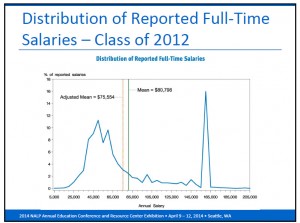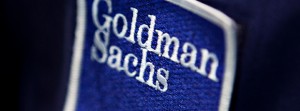I recently wrote about the depressing prospects for graduates of all but the top ten or twenty law schools (Two Law Grad Markets). And yes, these were statistical generalizations, and the experience of specific individuals with particular skills and backgrounds will always be different, pro and con. But as an industry, if you care about our supply chain for talent, many law schools are burning platforms.
There are actually some closely connected problems driving this dynamic:
- More JD’s are being turned out each year than there are (a) full-time; (b) long-term jobs (c) requiring bar passage (d) at current salary levels;
- Perhaps the primary reason for the mismatch between supply of JD’s and current demand for them (about two supplied for every one today’s market is demanding) is that clients increasingly resist paying for junior associates, which makes it uneconomic for firms to invest in traditional training;
- But/and at the same time every sentient observer is painfully aware that vast segments of the US population—consumers and businesses alike—remain underserved by lawyers.
This would prompt any economist to ask, almost instinctively, “Why isn’t there a market-clearing price where supply and demand can meet?”
Which is another way of asking, “What if there were a way to address both these problems at a single stroke?”
The short-term answer to why the market isn’t clearing is found in the bimodal salary distribution curve I cited in the earlier column.
Back in August 2012, NALP published a research paper outlining the history of this salary curve going back to the Class of 1991, when it bore a much closer resemblance to a normal, and to-be-expected, bell curve. Usefully, or for those of you who are gluttons for encounters with statistics that have punishing real-world consequences, NALP has also published a recap of the curve from 2006 to 2012, here.
You might well ask: Where did this curve come from?
The frankly bizarre bimodal distribution first appeared with the Class of 2000 when, in a classic case of “buying at the top,” the Silicon Valley firm Gunderson Dettmer decided to stake a claim to being among the top-tier firms out there and raised starting associate salaries from $100,000 to $125,000. (They made the move in 1999 just as the dot-com bubble was about to burst; I told you it was classic bad timing.)
Law firms being law firms, they followed like sheep and we have been living with the bimodal distribution curve ever since.
And now, you might well ask: How does it continue to endure, six years past the Great Reset?
Law firms being law firms, no one has been willing to break ranks and drive a stake into more rational ground.
We are dealing here with an expensive and irrational exercise in law firms’ “signalling” to the market that they are at the top of the pecking order—because they’re willing to overpay for entry-level talent. Note: When I say this behavior is “irrational,” I’m speaking of having a market stuck in this unstable posture; let me hasten to add that the behavior of any given firm contributing to this bizarro structure may seem, to it, rationally compelled precisely by the prevailing irrationality. This is a problem known as that of “collective action,” and it can be a thorny one indeed.
A final word on how irrational this is: We don’t seem to see it in any comparable market for entry-level talent. Indeed, not even two weeks ago Harvard Business Review published “The Real Reason New MBAs Want to Work for Goldman Sachs,” describing a market utterly congruent to that for first-year associates in all ways but salary lunacy:
What attracts top talent? Is it great benefits, flexible hours, steep pay packages, or state-of-the-art training? New research suggests it’s something simpler – but more difficult to obtain.
Prestige.
The status of a firm is quite possibly the leading driver in attracting the best of the best […] [I]n particular, [the Wharton professors] wanted to find out whether the ability to offer more money is really a competitive advantage. Investment banking in particular offered a good testing ground for these questions because there’s a clear hierarchy of firms, and because a firm’s place in that pecking order is readily quantifiable via surveys on websites like Vault.com […]
When they polled current MBA students applying to work at investment banks, “the extent to which firm reputation would help with future employability” was ranked as their most important decision-making factor.
Because of this, high salaries aren’t a competitive advantage, at least at first. “You get the best people
, and you don’t have to pay as much as you should early on because they want the stamp of ‘Goldman Sachs.’” [emphasis supplied]
Of course, we’re so much smarter than investment bankers, and savvier at running our firms to boot, so feel free to ignore this.
But back to where we came in.
Is there any way, within a functioning, for-profit, self-sustaining market-driven economy, to square this circle of mismatched supply and demand?
Introducing OnRamp’s “bridge to practice” program, a/k/a “ApprenticeRamp.” Paul Lippe, CEO of OnRamp Systems (and, disclosure,
a long-time friend) wrote about it in a recent ABA Journal.
I won’t here rehearse what Paul said in that article, but the way I think of the program integrates several components to create a new type of bridge (or, forgive me, “ramp”) between 3L graduation and the beginnings of mastery of what it means to practice as a 21st Century lawyer:
- Fundamental, core reliance on a foundation of processes, technology, and systems to undergird the actual work;
- A new approach to large scale, highly complex projects (which lawyers have traditionally been shockingly poor at handling), while working collaboratively;
- Rapid, powerful, systematized, and continuous feedback on performance for the new lawyers;
- While, all at once, delivering tangible market value to clients.
The initiative started with a growing list of 12 participating law schools—Boston College, Colorado, Denver, Emory, Georgetown, Hastings, McGeorge, Northeastern, Northwestern, Ohio State, USC, and Vanderbilt—who nominate recent grads for the program, and a global bank (which must remain anonymous, although they have acted as “co-designers” of the ApprenticeRamp program and protocols) which needs an extremely large-sale contract review process undertaken for Dodd-Frank compliance. At any given time, there are now about 60 apprentices in the program, growing to 150 by this summer and probably 300 by year-end, and there is no requirement that one “graduate” by a date certain and leave the program. At least at this early stage, as long as one can and wants to continue to contribute to building the program, and assume more senior roles (lead the next project for a customer, for instance), people can stay.
Part of the core genius of this program, from my perspective, is how it addresses an unserved or certainly underserved hole in the market: Projects, such as this “contract genome mapping” (Paul’s phrase) require a mix of technology and legal expertise that are far outside any realistic expectation of what an inhouse law department could be expected to tackle, but also a project that it would be risibly prohibitive to ask a law firm to address.
A few days ago I had a chance to talk with Randy Nickel, CIO of OnRamp, and gained some insight into how ApprenticeRamp actually works. Some highlights:
- The core legal work is documenting a large number of characteristics, terms, conditions, and operative clauses of an enormous number of contracts. The obvious technology (well, obvious to somebody like Randy with an extensive Valley IT background) is a full relational database built on MySQL (an open source implementation of “Structured Query Language”) that integrates document information with metadata.
- Because the work is done online, security is paramount. According to Randy, OnRamp has deployed a very sophisticated (and, I gather, not cheap) software tool to relentlessly probe for holes in the system; he said it can generate reports the size of an old-fashioned telephone book. (Target stores, take heed.) As Randy says, with the wry voice of experience, “the reality is that most systems are vulnerable somewhere, so the question is whether you know where the vulnerability is.”
- Randy also had some interesting observation about the 20-somethings working in the ApprenticeRamp program. To paraphrase, “they’re more tech-savvy than the typical user we’re familiar with; some of these differences are generational, such as a more collaborative workstyle, but not all. They’re not shy, not ‘leave me alone so I can focus on what I’m doing.'”
- Collaboration and feedback are at the core of the system; “if lawyers have a reputation as know-it-all’s, this group is learn-it-all’s.”
- Users can see the “quality assurance” results after their work is done; and if a response is deemed “wrong,” they can even challenge it, which double-checks the QA at the same time. Going to a specific Yes/No answer and hovering over it displays a full discussion of why the question was answered the way it was; drilling down further takes you to the actual page and clause in the contract that gave rise to t hat answer.
- Because so much data is captured, the system can begin to seek patterns of “bad” contracts, looking for clusters that correlate with a particular geography, time-frame, or manager at the financial institution—and display results using visualization tools.
Daniel Rodriguez, Dean of Northwestern Law, has said about it:
The productivity challenge in legal services provision, particularly in the space created by major technological and global change of the past three (or so) decades, is well known and has been for quite a while. Yet, we have become stuck in our efforts to respond to these changes and we are just beginning the essential project of developing truly original ideas for improving lawyer competence and, moreover, giving young lawyers the tools they need to adapt to this dynamic world.
Programs like OnRamp’s are a promising pathway to becoming “unstuck.”
Similarly, Boston University Law School Dean Maureen O’Rourke told me:
It will take some time to figure out whether this is the technology that will help advance 3L’s into practice, but it is already helping.
I also had a chance to talk to three of the “Rampers” (apprentices): Shanique Nikel of Northwestern, Zach Jones of Harvard, and Stephanie Wong of Hastings.
Each came to ApprenticeRamp via a different path: Zach because he took a 1L course on “reinventing the legal profession,” Shanique because she’d worked for the Fed before law school and thus had an interest in banking, and Stephanie because she’d always been interested in contract drafting but the contracts courses in law school “felt like it was in a box” and wasn’t practical.
What’s a “typical” day?
First, understanding what the client is looking for in contract analysis, then learning how to become expert at what you’re asked to do. Many days also involve a dose of “rounds”—modeled after the medical student/hospital residency custom, where students learn from senior experts, and/or meetings with potential and current clients.
You get to meet with clients? Really?
Yes, starting just six to eight weeks into the program, Stephanie was joining pitches to customers, which she notes drily “is probably not what the typical new associate gets.” And: “I feel as though I’ve learned so much in just 5 to 6 months; I’ve had opportunities other people haven’t.”
What do you want people to know about the experience? In no particular order, but as they responded:
- How quickly you learn about contracts; you get constant feedback through the system.
- The available resources “amazing; I felt like I learned more about contracts in my first two weeks at OnRamp than in all my past internships put together.”
- Metrics are terrific; you can see your performance and track it in real time. “In other positions you wouldn’t get such rigorous feedback all the time.”
- The organization seems “extremely forward-looking, not just in use of technology, but the way it goes about its business.” It’s a very flat structure; people are encouraged to find their own talent and then nurture it, which is “foreign to law firms, where you’re expected to do a certain type of work until maybe somebody realizes you have another skill.”
- “Law firms engage in very short-term thinking [in terms of their business model] but OnRamp is trying to be creative and open to solving problems to meet client needs using any tools and means they can come up with.”
- “One thing you don’t learn in law school but is really important in this role is knowing more about the business of law. [This was music to my ears.] You also learn things at OnRamp like project management: Creating a project plan, creating and sequencing tasks for a project, assigning resources to achieve those tasks. It’s not just substantive law.”
- Zach stresses how “dense the learning environment is,” as compared to law school where “you get essentially no feedback until maybe the end of the semester.” This adds up: “Find me a law firm that’s invested enough in their associates to put them in front of the deputy GC of a major bank.”
Talk about attrition among the apprentices: Do you see people drop out? Has anyone said, “this just isn’t for me?”
(They have to think about this.) Finally, “somebody left within two months because they got their dream job offer elsewhere.” Then they qualify it: “I think; not sure. But nobody has ever said, ‘this isn’t for me.'”
[Let’s pause, shall we, and compare that with the reactions of three typical junior associates in law firms. No need to tarry on this thought lest it interfere with your digestion.—Bruce]What’s the reaction of your peers? Of your law schools? (On this they are extremely voluble.)
Zach volunteers that the “typical law student just wants a secure job but has no idea what that actually means; OnRamp grads have far more specific and realistic expectations about what jobs can be. Classmates would ask me, ‘OK, are you going to look for a real job now?'”
Shanique volunteers that she didn’t expect to stay at OnRamp very long, and in fact got a job offer a few months ago at what she calls a “conventional company” (in-house): She asked how the company planned to grow people over (say) the next five years of their careers “and their answer was disappointing.” She adds a sophisticated observation: “Their environment was far too unstructured, with no way for the company to evaluate recent arrivals vs. longer-term employees.” [Sound familiar?—Bruce.]
As for law schools’ attitude, as recently as nine months to a year ago it was “tons of skepticism; we were very much encouraged to look for more conventional options by Career Services, [but] they’ve all been surprised by how quickly it’s taken off and how fast people are gaining value from it.” That doesn’t mean all schools are embracing it equally. One of them volunteers that at their school “the Dean is forward-looking but there’s a lot of pushback at Career Services; the only route to go is to a law firm.”
At Harvard, according to Zach, the issue is simply that hardly anyone knows about it; “the only people who do are ones I’ve told. But you have to understand the hiring dynamics at Harvard are very different; people aren’t looking outside the traditional model at all. ‘Alternatives’ are things like McKinsey and Citi.”
Could “alternatives” some day—even at empyrean Harvard—include ApprenticeRamp?
I for one am convinced we have to try…different. We have to spawn and spin out theories about ways to make this mismatched and dysfunctional market “clear.” We have to think big, experiment, test, revise, and test again. But mostly we have to start theorizing, and trying.
Paul Lippe:
We started by talking to people outside law—Intel, NASA, the project teams at global banks—and then spent more time listening to those lawyers who talk about what can be done, rather than those who dismiss what can’t. Over the last few months I have been talking to a lot of federal judges about problems of ‘Access to Justice,’ and now we’re beginning to work on applying these approaches to support very large scale clinical collaboration. Although addressing the access to justice challenge won’t require approaches as structured as our contract genome mapping work, it will require scale.
We think we’ve created a better mousetrap for uber-complex projects with iterative information requirements: And we’re betting on the young Rampers to help us improve it.
As the legendary Freeman Dyson recently wrote in The New York Review of Books, reviewing Mario Livio’s Brilliant Blunders: From Darwin to Einstein—Colossal Mistakes by Great Scientists That Changed Our Understanding of Life and the Universe:
Science consists of facts and theories. Facts and theories are born in different ways and are judged by different standards. Facts are supposed to be true or false. They are discovered by observers or experimenters. A scientist who claims to have discovered a fact that turns out to be wrong is judged harshly. One wrong fact is enough to ruin a career.
Theories have an entirely different status. They are free creations of the human mind, intended to describe our understanding of nature. Since our understanding is incomplete, theories are provisional. Theories are tools of understanding, and a tool does not need to be precisely true in order to be useful. Theories are supposed to be more-or-less true, with plenty of room for disagreement. A scientist who invents a theory that turns out to be wrong is judged leniently. Mistakes are tolerated, so long as the culprit is willing to correct them when nature proves them wrong.
ApprenticeRamp may or may not be around for a long time, and whatever happens of one prediction I’m confident: It will continue to evolve and morph. But for my money, it’s the best darned theory I’ve seen out there yet.




